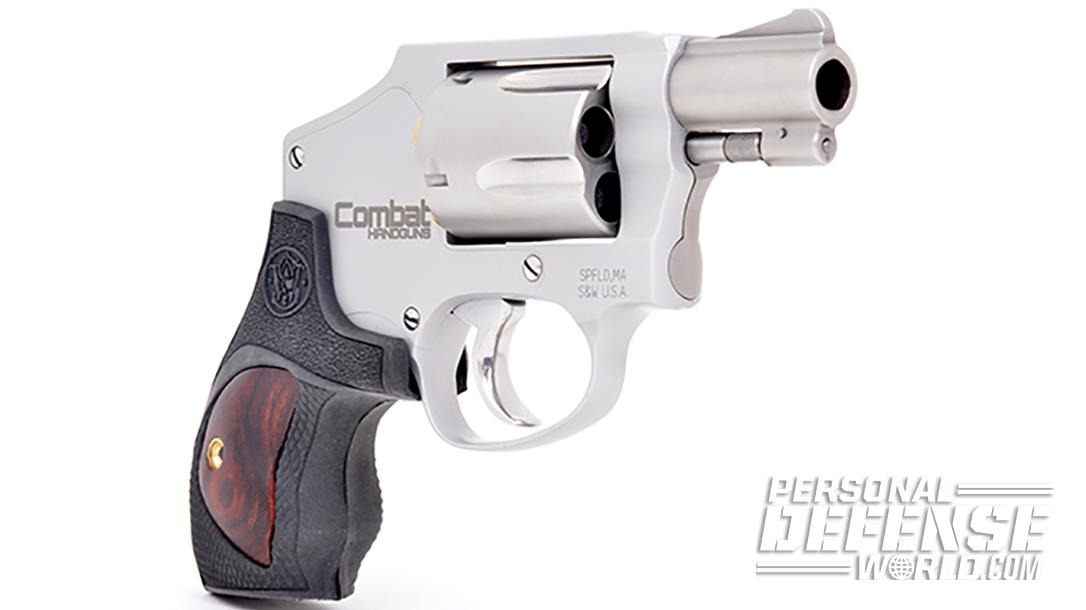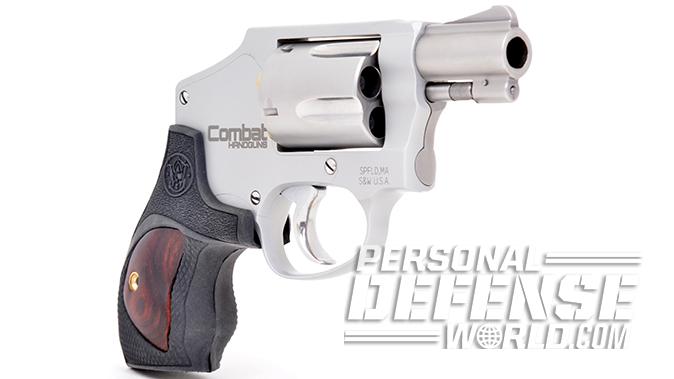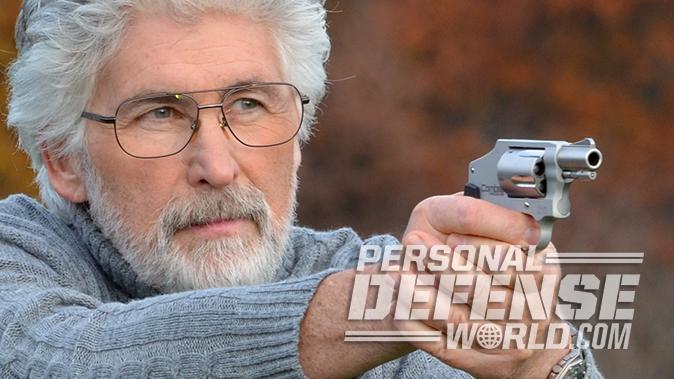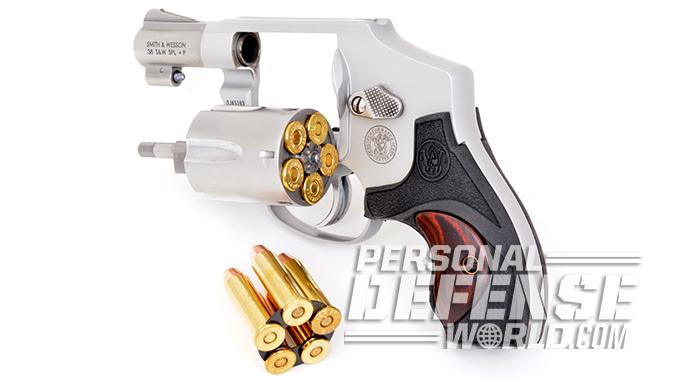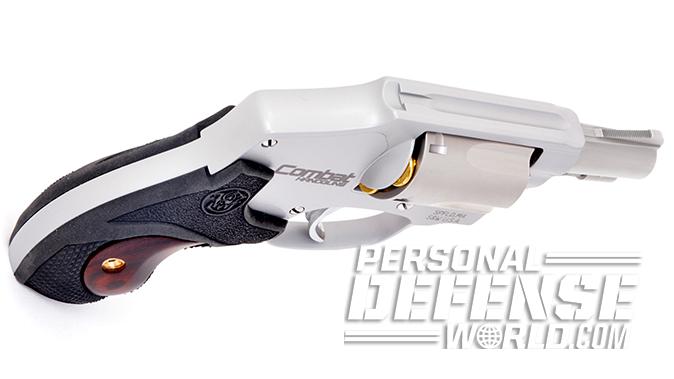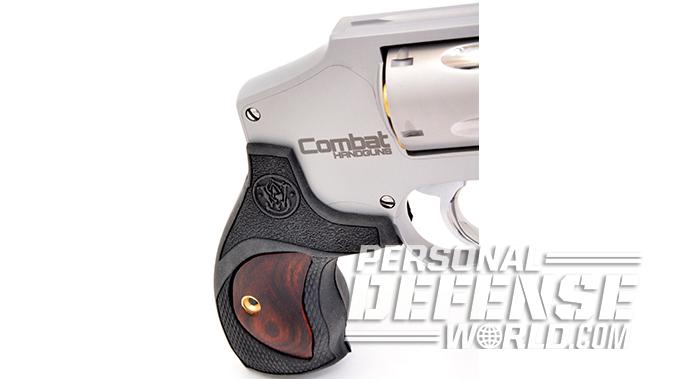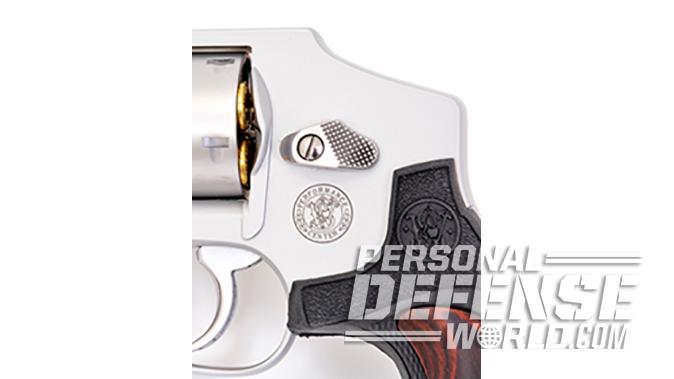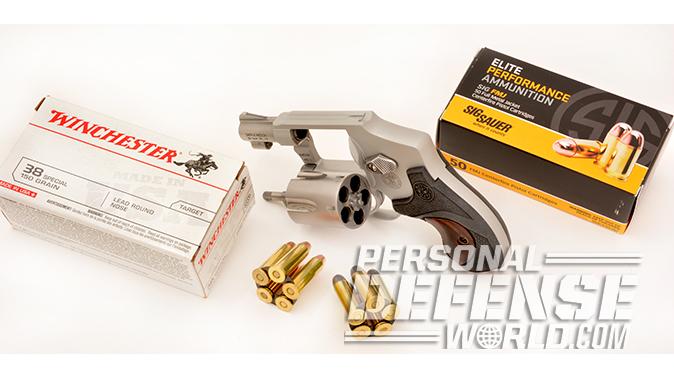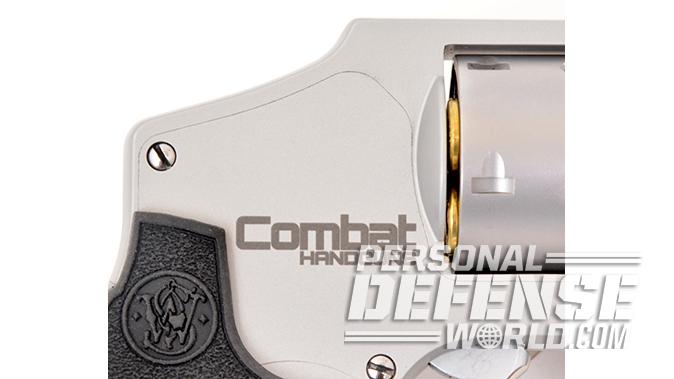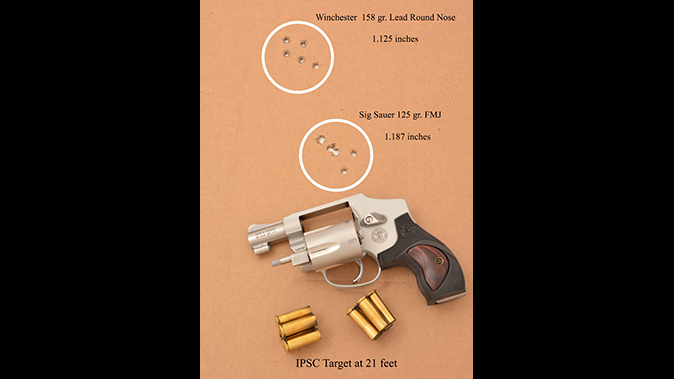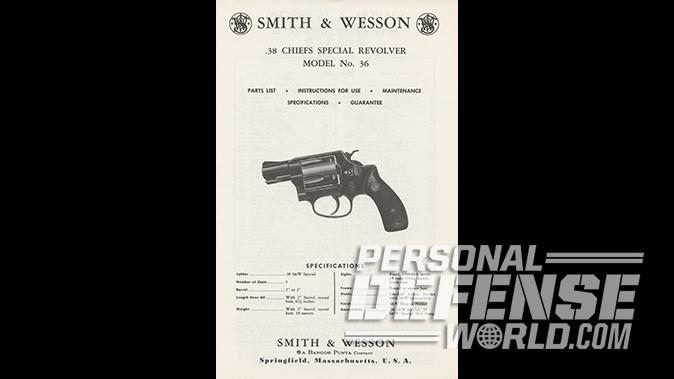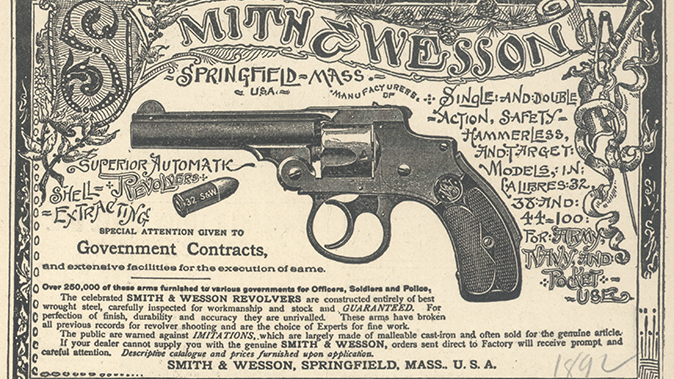Smith & Wesson’s J-Frame snub-nose revolvers have been around since 1950, when the Chief’s Special was introduced—later to become the S&W Model 36, but it’s always the “Chief’s Special” in the minds of those who knew the gun back in the day. The Model 36 was a traditional double-action/single- action (DA/SA) model, really Smith & Wesson’s response to the much older and then more famous Colt Detective Special.
A Bit Of History
As Colt continued to add variations of the Detective Special, Banker’s Special, Cobra and Agent over the years, S&W would begin building its own legacy, first with the 1950 DA/SA Chief’s Special, then the 1952 double-action-only (DAO) Model 40 Safety Hammerless or “Centennial Model” with a fully concealed hammer.
Advertisement — Continue Reading Below
The Model 40 was introduced to commemorate Smith & Wesson’s centennial year. The Model 38 Bodyguard with a shrouded hammer was added in 1955, and the Model 49 Bodyguard (similar to the Model 38) came in 1959. These formed the basis for a variety of model variations with lighter-weight frames: the S&W Model 37 Airweight, Bodyguard Airweight and Centennial Airweight. This all occurred in the 1950s, and there was a considerable emphasis on shrouded and concealed (hammerless) snub-nose designs for use by detectives and as uniformed officer backup and off-duty carry guns. S&W snub-nose models also became the gun of choice for fictional and real-life private detectives.
The snub-nose Hammerless design was one of the most popular “pocket” pistols of its time. Though the Model 40 was the first of its kind in the J-Frame line, its design had been pioneered by S&W back in 1888 with the First Model Safety Hammerless. The first top-break Hammerless Smith & Wesson models were chambered in .32 S&W and designed by S&W’s co-founder, Daniel B. Wesson. The Safety Hammerless used a backstrap-mounted safety bar that, when depressed by firmly grasping the gun, made the DAO revolver operable. It was intended to prevent an accidental discharge if the gun was dropped, a problem that afflicted many 19th century revolvers, leading to the practice of keeping the hammer rested on an empty chamber.
Those who abided by this turned their sixguns into five-shooters, and in the case of the smaller models, the cartridge capacity dropped from five to four. Wesson’s design allowed a fully loaded revolver to be carried without the fear of an accidental discharge. The internal-hammer design had one other advantage: In a tight situation, the gun could be fired from within a coat pocket without risk of a hammer spur or firing pin getting caught. This had great appeal to those on both sides of the law, and especially to women who could easily carry a snub-nose Safety Hammerless in a purse or clutch.
Advertisement — Continue Reading Below
Between 1888 and 1940, Smith & Wesson sold more than half a million Safety Hammerless top-breaks. Over 240,000 were chambered in .32 S&W and another 261,000 in the more powerful .38 S&W caliber, which remained in production after the .32-caliber models were discontinued in 1937. With our nation being drawn into World War II, demand for the compact top-break models increased, despite their obsolete design. Since S&W introduced the first Hand Ejector with a swing-out cylinder in 1896, top-break revolver sales had been declining, except for the Safety Hammerless.
One reason Hammerless models had continued to sell in the early 20th century was that they offered a shorter barrel length of 2 inches, compared to the shortest standard Hand Ejector barrel length of 3.25 inches. It wasn’t until 1915 that S&W began offering the .38 Military & Police Model with a 2-inch barrel. During WWII, many thousands of Safety Hammerless revolvers were carried by men who required a dependable and easily concealed pocket revolver.
The Legacy Continues
By 1950, top-break revolvers had mostly been relegated to collector status. For lawmen, the most popular sidearm in America, aside from a Colt Detective Special, was fast becoming the new Smith & Wesson J-Frame, the smallest modern production S&W revolver then and now. The hammerless Model 40 combined the best feature of the historic 1880s top-break Safety Hammerless with the latest Hand Ejector design. In the September 1953 issue of “American Rifleman,” Colonel Rex Applegate proclaimed the new Safety Hammerless models “potent, practical undercover handguns.”
Advertisement — Continue Reading Below
Smith & Wesson produced the Centennial and Centennial Airweight with an alloy frame—later designated as the Models 40 and 42—through 1974. The total combined production was over 300,000, and S&W hammerless snub-nose models became the first choice among self-defense handguns.
Today, more than six decades since the hammerless S&W Model 40 design was pioneered in 1952, Smith & Wesson is still embracing its historic roots by building snub-nose revolvers for undercover and personal-protection use. There are 20 different hammerless S&W variations available today with varying features and calibers, and lest we forget, S&W still manufacturers the shrouded-hammer Bodyguard and the original Model 36 Chief’s Special!
Advertisement — Continue Reading Below
The Model 642 is currently available in nine different versions, including Airweight models, those with lasers and some enhanced by the Performance Center, like the gun shown here. At the top of a laundry list of upgraded features for this Model 642 is a Performance-Center-tuned DAO trigger with a 20-percent improvement in trigger pull resistance and ease of operation.
Hand-fitted, the gun starts with an Airweight alloy frame; no internal lock (and thus the clean external looks of the older S&W Airweight models); a stainless steel barrel and cylinder; a special matte silver finish on the frame, barrel and cylinder; contrasting brightly polished cylinder flutes; and a chrome-plated and polished trigger face, thumbpiece and sideplate screws. Cut for full-moon clips, the cylinder allows for rapid reloading without a speedloader. The custom rubber grips have fancy hardwood inserts. In short, as snub-nose revolvers go, this one is a looker.
Standing Out
This special, one-of-a-kind .38 Special +P model has one feature that no other 642 offers—the “Combat Handguns” logo engraved on the right side of the frame in matte gray. This is a model that one lucky reader will end up owning!
Advertisement — Continue Reading Below
Getting a special-order gun starts with a call to Matt Spafford at the S&W Performance Center and scheduling a talk about extra features, special finishes or options like a ported barrel, custom grips or hand engraving. The Performance Center can do it all as well as internal upgrades to the actions. The only prerequisites are patience, time and money. I got together with Matt in mid-2017 to get the “Combat Handguns” model under way.
The first order of business was culling through the long list of possible guns, calibers, finishes and features. Since “Combat Handguns” puts a great deal of emphasis on defensive handguns and concealed-carry models, we knew from the start that it was going to be a snub-nose revolver, the perfect combat handgun since 1950. Rather than going for the obvious, a Chief’s Special Model 36, the discussion turned to the best backup and pocket guns. That meant either a shrouded hammer or a hammerless, two designs Smith & Wesson has mastered since the 1950s.
I am also what you might call a S&W Performance Center veteran, as I own half a dozen different handguns that have gone through that shop, including one that helped make the final decision on the “Combat Handguns” gun—a 1993 Model 640 Carry Comp, one of 150 built. This was my carry gun for a number of years and what became the inspiration for this particular build.
Advertisement — Continue Reading Below
History, too, had a great deal to do with the final pick and the legacy of S&W hammerless models. The Model 640 Centennial is still offered by S&W, but the Model 642 is just a hair smaller, making it an ideal CCW model in the classic tradition of the original Model 42 and later Model 640 Centennial circa 1990 (without the original grip safety).
The Performance Center Model 642 has an overall length of 6.3 inches including its 1.88-inch barrel, a truncated height of just 4.13 inches with the rubber grips flush to the bottom of the grip frame, a width of 1.19 inches at the cylinder, and a very carry-friendly weight of 15 ounces unloaded.
Advertisement — Continue Reading Below
The Performance Center upgrades take the average trigger pull from over 12 pounds to a modest 10.43 pounds. (In comparison, my Model 640 Carry Comp has an average trigger pull of 11.88 pounds.) The Performance Center trigger also handily stages the internal hammer as the cylinder rotates into battery, making a carefully aimed shot possible with almost single-action ease.
Handling & Shooting
Like all J-Frame snub-nose models, the five-shot Model 642 is easy to load with a speedloader, a speed strip or with full-moon clips if the cylinder is cut for them, and this special Performance Center pistol is. It comes with three 5-round clips.
Grip size is often an issue with J-Frame models, especially those without oversized grips, but the rubber grips here are so well contoured that they provide a solid hold on the gun with a slight undercut behind the triggerguard, and the little finger makes contact with the curved bottom of the grip rather than falling under it. The handsome wood panel inserts also provide a smooth wrap for the middle and third fingers. This is an ideal shape for small- to medium-sized hands and should even be adequate for those with slightly larger hands.
Advertisement — Continue Reading Below
J-Frame snub-nose models have never been much for sights (with the exception of rare target models), and a traditional topstrap channel and ramped front blade can do an admirable job of getting the gun on target if you have time for a carefully aimed shot. The rear notch on the Model 642 is deeper and wider than those on earlier models, and the matte silver finish on the frame helps reduce glare. For a J-Frame, this is about as good as fixed sights can get.
Despite having an Airweight frame, this Model 642 is rated for +P ammo but is always more challenging to handle in terms of recoil than with a traditional .38 Special round. Since someone is going to win this beauty, for the shooting test I decided to only shoot a minimum number of rounds and only use .38 Special ammunition.
I used a cardboard IPSC target set at 7 yards, and my ammunition included Winchester 150-grain lead round-nose (LRN) and Sig Sauer 125-grain FMJ loads. Using a two-handed Weaver stance, I fired the test shots in one-second intervals. The best five-shot group with the traditional Winchester LRN ammo measured 1.13 inches. The modern Sig Sauer FMJs clustered into 1.18 inches. Not bad for a snub-nose with only 1.88 inches of barrel length.
For some lucky winner, this one-of-a-kind “Combat Handguns” Model 642 is going to make a great EDC pistol—or one handsome gun cabinet trophy. Enter here to win!
S&W Model 642 Performance Center Specs
| Caliber: .38 Special +P |
| Barrel: 1.88 inches |
| OA Length: 6.3 inches |
| Weight: 15 ounces (empty) |
| Grip: Synthetic with wood inserts |
| Sights: Fixed |
| Action: DAO |
| Finish: Matte silver |
| Capacity: 5 |
| MSRP: N/A |
S&W Model 642 Performance Center Performance
| Load | Velocity | Accuracy |
|---|---|---|
| Sig Sauer 125 FMJ | 900 | 1.18 |
| Winchester 150 LRN | 845 | 1.13 |
*Bullet weight measured in grains. Velocity measured in fps by chronograph. Accuracy measured in inches for best five-shot groups at 7 yards.
For more information on the base gun, visit smith-wesson.com.
